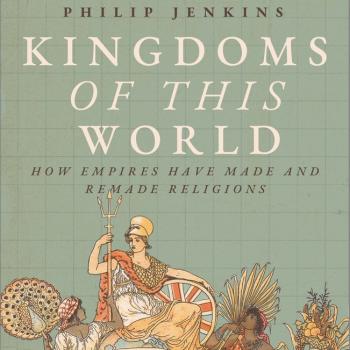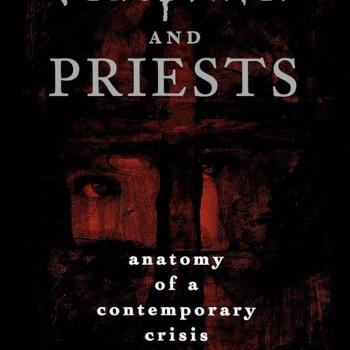Recently, I discussed teaching courses in Religious Studies, and specifically in World Religions. I always began such a course with what I called the building blocks of religion, and why we find the same themes across the spectrum of faiths – why certain numbers, colors, and so on enjoy special status across continents and civilizations. As the class proceeded, we would use these different themes and headings as a means of organizing and understanding material.
In the next couple of posts, I will be offering the materials I use to introduce these ideas. If these are of any use to you in teaching, or in thinking about religion, please take them as a professional gift for the coming academic year. If they are too obvious to be mentioned, then just ignore.
Do note that what I present here was meant to be introductory and general rather than academic in tone and format. One consequence of that is that I am not here touching on the substantial literature on these topics, prominent among which is Ann Taves’s outstanding 2009 book from Princeton, Religious Experience Reconsidered: A Building Block Approach to the Study of Religion and Other Special Things. This would demand far more consideration than I have space for here, and her efforts at definition and evaluation are critical. I just make the point that I am not appropriating her “building blocks” framework or terminology, which I was using independently fifteen years before her book appeared. Not that I am bitter (!). Seriously, we are using quite different approaches, and throughout, we identify very different “blocks.”
So: a standard repertoire of religious patterns and practices appears in the great majority of human societies, past and present. Whether in major world faiths or “primal” religions, people tend to do the same things as part of religious behavior, regardless of the scriptures or teachings specific to that particular culture. These are the building blocks, elements that are found in all the major world religions, though often they are dismissed as folk religion or superstition. To take an obvious example, the idea of making pilgrimage to the tombs or shrines of holy men and women is well known in the context of Christianity and Buddhism, but also appears in aspects of Islam and Judaism, in which the practice is sometimes condemned as superstitious. Similar “religious” elements also appear in secular or even anti-religious societies, though usually stripped of any obviously spiritual component.
Even the best Religious Studies textbooks iuse approaches that I believe are misleading, or perhaps unbalanced. (Check out that recent post on finding books about “lived religion” rather than scriptural religion). In order to make the complex material comprehensible to a student audience, textbook writers usually present the various religious traditions as discrete units, paying insufficient attention to common themes and patterns. In addition, they commonly place too much emphasis on texts and scriptures, rather than the actual lived experience of the religions in question. Consciously or otherwise, this approach lends support to the rather dated idea of “high” and “low” religion. In this view, those people following the approved scriptural norms are the correct practitioners of the religion, while out there in the wilds, ordinary people are pursuing strange customs that derive from folk-custom, and may represent survivals of older religions. Obviously, I am oversimplifying, but the textbooks do reflect a strong prejudice towards the textual.
As we look around the world, though, we see that certain themes occur in virtually all societies with any notion of religion (which is basically all of them), and even those that are not obviously religious use the same notions in secularized form. This commonality is not all a result of influences from one people to another, since the same basic themes appear even in newly contacted societies never before in touch with the great societies of either West or East. These building blocks emerge powerfully in primal faiths, but they remain as undercurrents in the great religions.
In discussing these vestigial presences, these underlying survivals, I use the linguistic concept of “interference,” the term for how one’s original speech affects speaking patterns when a person tries and use a new language.
These kinds of interference exercise a powerful influence on religious practice, to the extent that major religions face significant problems when they try to exclude them altogether. Periodically through history, in all great religions, reformers seek to purge what they see as such fringe beliefs and practices, and demand a return to the sources of the religion, to the strict letter of the Bible, the Quran or the Vedas. Time and again, though, the underlying practices return, either within the mainstream religion itself, or else through the vehicle of new religious movements.
The concept of underlying common themes in religion is not new. This is the core idea we find in Jung’s theory of archetypes, the images of the collective unconscious that appear worldwide in dreams, myths and fairy stories. More recently, theories about the structure and workings of the brain suggest that certain kinds of religious behavior are hard-wired into the human mind, that religious states are an aspect of evolutionary biology. Books and media articles have explored ideas like “The Biology of Religious Experience,” even “The ‘God’ Part of the Brain.” These biologically determinist ideas – “NeuroTheology” – are controversial because they reduce human spirituality to the interplay of neurons.
My approach differd from these varieties of “universalism.” While acknowledging biological approaches to behavior, I believe that many of the common religious themes arise from fairly obvious facts of human existence, and do not require any elaborate knowledge of biology or biochemistry. Arguably, one of the best ways to trace the “roots of religion” is to observe small children, with their obsessive ritualism and powerful sense of taboo, their rich awareness of places possessed of good or evil powers.
So what are these common facts that apply to human beings in virtually all times and places? Students will usually come up with their own list of “universals”, so we can then explore the religious themes that arise from them. This is a clear means of introducing the reader to the basic structures or substructures of religion. In each case, I point to the themes common to all of us as human beings, and indicate how they give rise to religious beliefs or practices, illustrated from various societies and cultures past and present. We might use a contemporary example – such as people arguing with computers or and trying to bargain with stubborn ATM machines – before moving on to some more formal and overtly “religious” expression.
Throughout, we can use examples from primal religions, but also stress how these same ideas run through the “higher” faiths. To take an example, after discussing building blocks like breath and speech, I note how they are transformed in the “great” religions, how for instance breath becomes sacralized as spirit, and then Spirit – as prana, ruach, pneuma, and so on.
From a Christian perspective, such an approach helps us distinguish between generic religiosity and religious behavior and the authentic core of faith.
I’ll expand on these ideas and look at these possible “universals” in religious behavior.
I was delighted to see the discussion of many of these themes in Reza Aslan’s excellent book God: A Human History, which comes out from Random House this coming November. I recently had the opportunity to preview this.

















